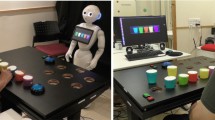Abstract
Due to their quantitative nature, robotic systems are useful tools for systematically augmenting human behavior and performance in dynamic environments, such as therapeutic rehabilitation settings. The efficacy of human-robot interaction (HRI) in these settings will depend on the robot’s coaching style. Our goal was to investigate the influence of robot coaching styles designed to enhance motivation and encouragement on post-stroke individuals during motor task practice. We hypothesized that coaching styles incorporating user performance and preference would be preferred in a therapeutic HRI setting. We designed an evaluation study with seven individuals post stroke. A socially assistive robotics (SAR) system using three different coaching styles guided participants during performance of an upper extremity practice task. User preference was not significantly affected by the different robot coaching styles in our participant sample (H(2) = 2.638, p = 0.267). However, trends indicated differences in preference for the coaching styles. Our results provide insights into the design and use of SAR systems in therapeutic interactions aiming to influence user behavior.
Similar content being viewed by others
References
D.J. Feil-Seifer and M.J. Matarić, Defining socially assistive robotics. In International Conference on Rehabilitation Robotics. Chicago, IL, 2005, 465–468.
T. Fong, I. Nourbakhsh, A survey of socially interactive robots. Robotics and Autonomous Systems, Special issue on Socially Interactive Robots 42,3–4, 2003, 143–166.
J. Tao and T. Tan, Affective computing: A review. Lecture Notes in Computer Science 3784, 2005, 981–995.
A. Duschau-Wicke, T. Brunsch, L. Lunenburger, and R. Riener, Adaptive support for patient-cooperative gait rehabilitation with the lokomat. IROS, 2008, 2357–2361.
S. Banala, S. Kim, S. Agrawal, and J. Scholz, Robot assisted gait training with active leg exoskeleton (alex). IEEE Trans Neural Syst Rehabil Eng. 17,1, 2009 (Feb.), 2–8.
D. Reinkensmeyer, L. Kahn, M. Averbuch, M. McKenna-Cole, and W. Rymer, Understanding and treating arm movement impairment after chronic brain injury: progress with the arm guide. J. Rehabil. Res. Dev. 37,6, 2000 (Nov–Dec), 653–662.
A.C. Lo, P.D. Guarino, L.G. Richards, J.K. Haselkorn, G.F. Wittenberg, D.G. Federman, R.J. Ringer, T.H. Wagner, H.I. Krebs, B.T. Volpe, C.T. Bever, D.M. Bravata, P.W. Duncan, B.H. Corn, A.D. Maffucci, S.E. Nadeau, S.S. Conroy, J.M. Powell, G.D. Huang, and P. Peduzzi, Robot-assisted therapy for long-term upper-limb impairment after stroke. N. Engl. J. Med. 326,19, 2010 (May), 1772–1783.
K. Dautenhahn, C.L. Nehaniv, M.L. Walters, B. Robins, H. Kose-Bagci, N.A. Mirza, and M. Blow, Kaspar-a minimally expressive humanoid robot for human-robot interaction research. Applied Bionics and Biomechanics 6,3, 2009, 369–397.
T. Shibata and K. Wada, Robot therapy-a new approach for mental healthcare of the elderly. Gerentology, 2010.
A. Tapus, M.J. Matarić, and B. Scassellati, The grand challenges in socially assistive robotics. IEEE Robotics and Automation Magazine 14,1, 2007 (Mar), 35–42.
J. Fasola and M.J. Matarić, Robot motivator: Improving user performance on a physical/mental task. In Proceedings of the International Conference on Human-Robot Interaction, 2009.
A. Tapus, C. Tapus, and M.J. Matarić, The use of socially assistive robots in the design of intelligent cognitive therapies for people with dementia. In International Conference on Rehabilitation Robotics, 2009.
D.J. Feil-Seifer, M.P. Black, M.J. Matarić, and S. Narayanan, Toward designing interactive technologies for supporting research in autism spectrum disorders. In International Meeting for Autism Research, 2009, Chicago, Il.
A. Parnandi, E. Wade, and M.J. Matarić, Motor function assessment using wearable inertial sensor. In 32nd Annual International Conference of the IEEE Engineering in Medicine and Biology Society (EMBC’10), 2010.
E. Wade, A. Parnandi, and M.J. Matarić, Automated administration of the wolf motor function test for post-stroke assessment. In ICST 4th International ICST Conference on Pervasive Computing Technologies for Healthcare 2010, 2010.
M.J. Matarić, A. Tapus, C.J. Winstein, and J. Eriksson, Socially assistive robotics for stroke and mild TBI rehabilitation. In Advanced Technologies in Rehabilitation. Vol. 145., 2009, IOS Press, 249–262.
World Health Organization, “Burden of disease statistics,” 2010, http://www.who.org.
R. Mead, E. Wade, P. Johnson, A.B.S. Clair, S. Chen, and M.J. Matarić, An architecture for rehabilitation task practice in socially assistive human-robot interaction. In 19th IEEE International Symposium in Robot and Human Interactive Communication, 2010, Viareggio, Italy.
M. Quigley, K. Conley, B. Gerkey, J. Faust, T. Foote, J. Leibs, R. Wheeler, and A. Ng, ROS: an open-source Robot Operating System ICRA Workshop on Open Source Software, 2009, Kobe, Japan.
M.J. Johnson, X. Feng, L.M. Johnson, and J.M. Winters, Potential of a suite of robot/computer-assisted motivating systems for personalized, home-based, stroke rehabilitation. J. NeuroEngineering and Rehabilitation 4,6, 2007 (March), 1–17.
C.D. Kidd, Designing for long-term human-robot interaction and application to weight loss. PhD Thesis, 2008, Massachusetts Institute of Technology.
J. Wainer, D.J. Feil-Seifer, D.A. Shell, and M.J. Matarić, Embodiment and human-robot interaction: A task-based perspective. In IEEE Proceedings of the International Workshop on Robot and Human Interactive Communication. 2007, Jeju Island, South Korea, 872–877.
R. Looije, M. Neerincx, and F. Cnossen, Persuasive robotic assistant for health self-management of older adults: Design and evaluation of social behaviors. Int. J. Human-Computer Studies 68, 2010, 386–397.
J. Fasola, and M.J. Matarić, Comparing Physical and Virtual Embodiment in a Socially Assistive Robot Exercise Coach for the Elderly. Submitted to 7th ACM/IEEE International Conference on Human-Robot Interaction. Boston, MA, USA, Mar. 2012.
J. Liepert, H. Bauder, W.H.R. Miltner, E. Taub, C. Weiler, Treatment-Induced Cortical Reorganization After Stroke in Humans. Stroke 31, 2000, 1210–1216.
S. Kiesler, Fostering common ground in human-robot interaction. IEEE Int. Workshop on Robot and Human Interactive Communication, 2005, 729–734.
R. Schmidt and T. Lee, Motor Control and Learning. Human Kinetics, 2005.
J. Lee and S. Marsella, Nonverbal behavior generator for embodied conversational agents. In 6th International Conference on Intelligent Virtual Agents. 2006, Marina Del Rey, California.
A. Fugl-Meyer, L. Jaasko, I. Leyman, S. Olsson, and S. Steglind, The post-stroke hemiplegic patient. 1. a method for evaluation of physical performance. Scandinavian J. of Rehab. Medicine 7,1, 1975, 13–31.
E. Mower, D.J. Feil-Seifer, M.J. Matarić, and S. Narayanan, Investigating implicit cues for user state estimation in human-robot interaction using physiological measurements. In IEEE Proceedings of the International Workshop on Robot and Human Interactive Communication. 2007, Jeju Island, South Korea.
F. Rose, E. Attree, A. Brooks, D. Parslow, P. Penn, and N. Ambihaipahan, Training in virtual environments: transfer to real world tasks and equivalence to real task training. Ergonomics 43,4, 2000 (Apr), 494–511.
S. Braun, M. Kleynen, J. Schols, T. Schack, A. Beurskens, D. Wade, Using mental practice in stroke rehabilitation: a framework. Clin. Rehabil. 2008 Jul;22(7):579–91.
M. Guadagnoli and T. Lee, Challenge point: a framework for conceptualizing the effects of various practice conditions in motor learning. J. Mot. Behav. 36,2, 2004, 212–224.
S.B. Thies, P.A. Tresadern, L.P. Kenney, J. Smith, D. Howard, J.Y. Goulermas, C. Smith, J. Rigby, Movement variability in stroke patients and controls performing two upper limb functional tasks: a new assessment methodology. J. Neuroeng. Rehabil. 6,2, 2009.
A. Handley, P. Medcalf, K. Hellier, D. Dutta, Movement disorders after stroke, Age Ageing 38,3, 2009, 260–266.
Author information
Authors and Affiliations
Corresponding author
About this article
Cite this article
Wade, E., Parnandi, A., Mead, R. et al. Socially assistive robotics for guiding motor task practice. Paladyn 2, 218–227 (2011). https://doi.org/10.2478/s13230-012-0017-0
Received:
Accepted:
Published:
Issue Date:
DOI: https://doi.org/10.2478/s13230-012-0017-0




